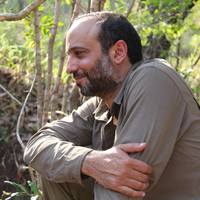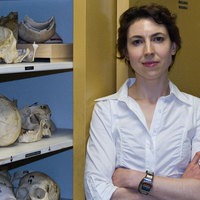
Jenny Gregory
Related Authors
James Elkins
School of the Art Institute of Chicago
Maurice Yolles
Liverpool John Moores University
J. H. Chajes
University of Haifa
Amir Manbachi
Johns Hopkins University
Felipe Martinez
Pontificia Universidad Catolica de Chile
Joao Comba
Universidade Federal do Rio Grande do Sul
Katherine Mason
Miami University
Julia Boughner
University of Saskatchewan
Fabio Cuzzolin
Oxford Brookes University
Lev Manovich
Graduate Center of the City University of New York
InterestsView All (14)










Uploads
Papers by Jenny Gregory
The shape of the vocal tract and associated structures (e.g. tongue and velum) is complicated and varies according to development and function. This variability challenges interpretation of voice experiments. Quantifying differences between shapes and understanding how vocal structures move in relation to each other is difficult using traditional linear and angle measurements. With statistical shape models, shape can be characterized in terms of independent modes of variation. Here, we build an active shape model (ASM) to assess morphological and pitch-related functional changes affecting vocal structures and the airway.
Method
Using a cross-sectional study design, we obtained 6 midsagittal MR images from 10 healthy adults (5 males and five females) at rest, while breathing out, and while listening to and humming low and high notes. Eighty landmark points were chosen to define the shape of interest and an ASM was built using these (60) images. Principal component analysis was used to identify independent modes of variation and statistical analysis was performed using one-way repeated-measures ANOVA.
Results
Twenty modes of variation were identified with modes 1 and 2 accounting for half the total variance. Modes 1 and 9 were significantly associated with humming low and high notes (P < 0.001) and showed coordinated changes affecting the cervical spine, vocal structures and airway. Mode 2 highlighted wide structural variations between subjects.
Conclusion
This study highlights the potential of active shape modelling to advance understanding of factors underlying morphological and pitch-related functional variations affecting vocal structures and the airway in health and disease.
Traditional voice research occurs within a phonetic context. Accordingly, pitch-related contributions are inseparable from those due to articulator input. In humming, articulator input is negligible. Using MRI we test the hypothesis that voice production is accompanied by pitch-related adjustments unrelated to articulatory or postural input.
Study Design / Method
In this cross-sectional study, 10 healthy volunteers (5 males, 5 females, age 20-47, median 25 years) including singers (6 months-10 years tuition, median 2 years) and non-singers, were assessed to establish the lowest and highest notes they could comfortably sustain while humming over 20 seconds. With head position stable, mid-sagittal images were acquired while volunteers hummed these predetermined low and high notes. 22 craniocervical, angular and linear dimensions defined on these images were compared using One Way Repeated Measures ANOVA. Correlations between variables were sought using Pearson’s correlation coefficient.
Results
We found significant differences between low and high note conditions in 6/22 measures and widespread pitch-related correlations between variables (r ≥ 0.66, P < 0.05). Compared with low note humming, high note humming was accompanied by increased craniocervical angles opt/nsl and cvt/nsl (P = 0.008 and 0.002 respectively); widening of the C3-menton distance (P = 0.003), a rise of the larynx and hyoid in relation to the cranial base (P = 0.012 and < 0.001 respectively) and a decreased sternum-hyoid distance (P = 0.004).
Conclusion
Voice production is accompanied by pitch-related adjustments that are currently being masked by, or mistakenly attributed to, articulatory or postural input, identification of which could improve understanding of mechanisms underlying speech and song.
Traditional voice research focuses upon the vocal tract, articulators and larynx. By ignoring their direct/indirect attachments (skull, cervical spine, sternum) important information may be missed. We aim to investigate vocal structures within this wider context and assess the validity of this approach for subsequent voice production studies.
Study Design / Method
Using a cross-sectional study design we obtained mid-sagittal MR images from ten healthy adults (5 males, 5 females) while at rest and breathing quietly. With reference points based upon cephalometry, 17 craniocervical, craniocaudal and antero-posterior variables were chosen to describe craniofacial morphology, craniocervical posture and airway dimensions. Relationships between variables were sought using Pearson’s correlation coefficient.
Results
We found widespread correlations relating vocal structures to the craniofacial skeleton and cervical spine (r > 0.6). Increasing airway size (hyocervical distance) was associated with greater distances from the cranial base of the hyoid, larynx, epiglottis tip and uvula tip, and of C3 from the menton. A wider velopharyngeal opening was associated with a shorter and higher soft palate, and a greater (lower) craniocervical angle was associated with a wider laryngeal tube opening, narrower airway at the uvula tip and shorter distances of the hyoid and uvula tip from the cranial base.
Conclusion
Finding widespread correlations relating vocal structures to the craniofacial skeleton and cervical spine confirms the potential of this approach to uncover functional activity during voice production and demonstrates the importance of considering vocal structures and the airway within this wider context if important information is not to be missed.
Keywords
MRI-Cephalometry-Vocal Tract-Speech-Posture
***Highlighted by Faculty of 1000 ***
http://facultyof1000.com/
Background
This study presents an analysis of trabecular bone structure in standard radiographs using Fourier transforms and principal components analysis (PCA) to identify contributions to hip fracture risk.
Methods
Radiographs were obtained from 26 hip fracture patients and 24 controls. They were digitised and five regions of interest (ROI) were identified from the femoral head and neck for analysis. The power spectrum was obtained from the Fourier transform of each region and three profiles were produced; a circular profile and profiles parallel and perpendicular to the preferred orientation of the trabeculae. PCA was used to generate a score from each profile, which we hypothesised could be used to discriminate between the fracture and control groups. The fractal dimension was also calculated for comparison. The area under the receiver operating characteristic curve (Az) discriminating the hip fracture cases from controls was calculated for each analysis.
Results
Texture analysis of standard radiographs using the fast Fourier transform yielded variables that were significantly associated with fracture and not significantly correlated with age, body mass index or femoral neck bone mineral density. The anisotropy of the trabecular structure was important; both the perpendicular and circular profiles were significantly better than the parallel-profile (P < 0.05). No significant differences resulted from using the various ROI within the proximal femur. For the best three groupings of profile (circular, parallel or perpendicular), method (PCA or fractal) and ROI (Az = 0.84 – 0.93), there were no significant correlations with femoral neck bone mineral density, age, or body mass index. PCA analysis was found to perform better than fractal analysis (P = 0.019).
Conclusions
Both PCA and fractal analysis of the FFT data could discriminate successfully between the fracture and control groups, although PCA was significantly stronger than fractal dimension. This method appears to provide a powerful tool for the assessment of bone structure in vivo with advantages over standard fractal methods.
The shape of the vocal tract and associated structures (e.g. tongue and velum) is complicated and varies according to development and function. This variability challenges interpretation of voice experiments. Quantifying differences between shapes and understanding how vocal structures move in relation to each other is difficult using traditional linear and angle measurements. With statistical shape models, shape can be characterized in terms of independent modes of variation. Here, we build an active shape model (ASM) to assess morphological and pitch-related functional changes affecting vocal structures and the airway.
Method
Using a cross-sectional study design, we obtained 6 midsagittal MR images from 10 healthy adults (5 males and five females) at rest, while breathing out, and while listening to and humming low and high notes. Eighty landmark points were chosen to define the shape of interest and an ASM was built using these (60) images. Principal component analysis was used to identify independent modes of variation and statistical analysis was performed using one-way repeated-measures ANOVA.
Results
Twenty modes of variation were identified with modes 1 and 2 accounting for half the total variance. Modes 1 and 9 were significantly associated with humming low and high notes (P < 0.001) and showed coordinated changes affecting the cervical spine, vocal structures and airway. Mode 2 highlighted wide structural variations between subjects.
Conclusion
This study highlights the potential of active shape modelling to advance understanding of factors underlying morphological and pitch-related functional variations affecting vocal structures and the airway in health and disease.
Traditional voice research occurs within a phonetic context. Accordingly, pitch-related contributions are inseparable from those due to articulator input. In humming, articulator input is negligible. Using MRI we test the hypothesis that voice production is accompanied by pitch-related adjustments unrelated to articulatory or postural input.
Study Design / Method
In this cross-sectional study, 10 healthy volunteers (5 males, 5 females, age 20-47, median 25 years) including singers (6 months-10 years tuition, median 2 years) and non-singers, were assessed to establish the lowest and highest notes they could comfortably sustain while humming over 20 seconds. With head position stable, mid-sagittal images were acquired while volunteers hummed these predetermined low and high notes. 22 craniocervical, angular and linear dimensions defined on these images were compared using One Way Repeated Measures ANOVA. Correlations between variables were sought using Pearson’s correlation coefficient.
Results
We found significant differences between low and high note conditions in 6/22 measures and widespread pitch-related correlations between variables (r ≥ 0.66, P < 0.05). Compared with low note humming, high note humming was accompanied by increased craniocervical angles opt/nsl and cvt/nsl (P = 0.008 and 0.002 respectively); widening of the C3-menton distance (P = 0.003), a rise of the larynx and hyoid in relation to the cranial base (P = 0.012 and < 0.001 respectively) and a decreased sternum-hyoid distance (P = 0.004).
Conclusion
Voice production is accompanied by pitch-related adjustments that are currently being masked by, or mistakenly attributed to, articulatory or postural input, identification of which could improve understanding of mechanisms underlying speech and song.
Traditional voice research focuses upon the vocal tract, articulators and larynx. By ignoring their direct/indirect attachments (skull, cervical spine, sternum) important information may be missed. We aim to investigate vocal structures within this wider context and assess the validity of this approach for subsequent voice production studies.
Study Design / Method
Using a cross-sectional study design we obtained mid-sagittal MR images from ten healthy adults (5 males, 5 females) while at rest and breathing quietly. With reference points based upon cephalometry, 17 craniocervical, craniocaudal and antero-posterior variables were chosen to describe craniofacial morphology, craniocervical posture and airway dimensions. Relationships between variables were sought using Pearson’s correlation coefficient.
Results
We found widespread correlations relating vocal structures to the craniofacial skeleton and cervical spine (r > 0.6). Increasing airway size (hyocervical distance) was associated with greater distances from the cranial base of the hyoid, larynx, epiglottis tip and uvula tip, and of C3 from the menton. A wider velopharyngeal opening was associated with a shorter and higher soft palate, and a greater (lower) craniocervical angle was associated with a wider laryngeal tube opening, narrower airway at the uvula tip and shorter distances of the hyoid and uvula tip from the cranial base.
Conclusion
Finding widespread correlations relating vocal structures to the craniofacial skeleton and cervical spine confirms the potential of this approach to uncover functional activity during voice production and demonstrates the importance of considering vocal structures and the airway within this wider context if important information is not to be missed.
Keywords
MRI-Cephalometry-Vocal Tract-Speech-Posture
***Highlighted by Faculty of 1000 ***
http://facultyof1000.com/
Background
This study presents an analysis of trabecular bone structure in standard radiographs using Fourier transforms and principal components analysis (PCA) to identify contributions to hip fracture risk.
Methods
Radiographs were obtained from 26 hip fracture patients and 24 controls. They were digitised and five regions of interest (ROI) were identified from the femoral head and neck for analysis. The power spectrum was obtained from the Fourier transform of each region and three profiles were produced; a circular profile and profiles parallel and perpendicular to the preferred orientation of the trabeculae. PCA was used to generate a score from each profile, which we hypothesised could be used to discriminate between the fracture and control groups. The fractal dimension was also calculated for comparison. The area under the receiver operating characteristic curve (Az) discriminating the hip fracture cases from controls was calculated for each analysis.
Results
Texture analysis of standard radiographs using the fast Fourier transform yielded variables that were significantly associated with fracture and not significantly correlated with age, body mass index or femoral neck bone mineral density. The anisotropy of the trabecular structure was important; both the perpendicular and circular profiles were significantly better than the parallel-profile (P < 0.05). No significant differences resulted from using the various ROI within the proximal femur. For the best three groupings of profile (circular, parallel or perpendicular), method (PCA or fractal) and ROI (Az = 0.84 – 0.93), there were no significant correlations with femoral neck bone mineral density, age, or body mass index. PCA analysis was found to perform better than fractal analysis (P = 0.019).
Conclusions
Both PCA and fractal analysis of the FFT data could discriminate successfully between the fracture and control groups, although PCA was significantly stronger than fractal dimension. This method appears to provide a powerful tool for the assessment of bone structure in vivo with advantages over standard fractal methods.